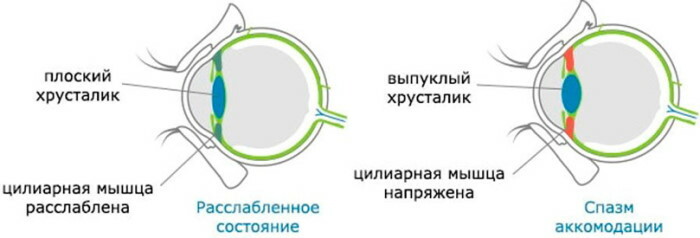Content
- Views
- Stages and degrees
- Symptoms and Signs
- The first signs of laryngospasm
- Night attacks
- Causes
- Most common causes
- Diagnostics
- Treatment methods
- Surgical operations
- Physiotherapy methods
- Traditional methods
- Possible consequences and complications
- Laryngospasm videos
Laryngospasm in adults and children - This is a sudden contractile spasm of the muscles of the larynx, often requiring urgent treatment. Symptoms are shortness of breath with heavy breathing, which is complemented by convulsions, sudden bowel movements, or urination. Provokes a narrowing, complete overlap of the vocal opening. If the attack is not removed in time, then the person may die from asphyxia.
Views
Laryngospasm is a sudden onset of narrowing of the larynx with a high risk of death. The disease can be primary or secondary, it is caused by other pathologies, inflammations.
There are three types of laryngospasm:
- Infectious. It rarely occurs. The infection itself does not provoke a disorder, but creates favorable conditions for the development of the pathological process.
- Allergic. It can be primary if it develops spontaneously, without signs of prior damage. Or secondary, when the spasm is caused by trauma, infection. Both varieties are very dangerous.
-
Mixed. It combines the first two varieties. The mixed look is difficult to correct, especially in the chronic form due to the infectious process.

Laryngospasm in adults
After 18 years, the likelihood of seizures is significantly reduced due to the completion of the formation of the airways and larynx.
Stages and degrees
Laryngospasm in adults (symptoms and treatment depend on the stage of the disease), according to the severity, are divided into 4 types:
- First. There are no clinical symptoms, only a slight narrowing of the larynx is diagnosed. The patient experiences mild discomfort, which he perceives as a minor health disorder and does not associate it with spasms. The first degree of laryngospasm is not dangerous, but it can start to progress. Therefore, regular monitoring of the patient's condition is required.
- Second. Symptoms increase slightly, the patient has mild respiratory failure. Breathing disorder, blue nasolabial triangle may occur. Symptoms increase with vigorous physical activity. The skin turns pale, becomes a waxy shade. But the second degree of laryngospasm responds well to treatment, the person recovers quickly. If there is no treatment, then the disease becomes unpredictable and abruptly moves into the next stage.
- Third. All the symptoms of laryngitis appear, the lumen is greatly narrowed, overlapped by more than 50 percent. Severe respiratory failure occurs. The pathological process does not go away on its own, it gradually intensifies. In addition, drowsiness, weakness and blue skin are noted. There is a real threat to life. This condition requires urgent medical attention, quick correction. The patient's condition is aggravated by a severe panic attack. The patient develops an unaccountable fear, excitement, anxiety. Excessive erratic fussiness.
- Fourth. This is the most severe degree of laryngospasm, which is characterized by critical respiratory distress, serious cardiac abnormalities. If urgent medical attention is not provided, then a person dies in a few minutes.
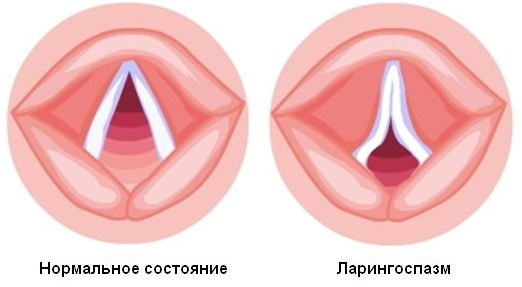 In the form of manifestation, laryngospasm can be mild or severe. In the first case, doctors quickly eliminate symptoms, restore breathing and oxygen supply. In severe cases, it is difficult to remove an attack, often doctors do not have time to help, and a fatal outcome occurs.
In the form of manifestation, laryngospasm can be mild or severe. In the first case, doctors quickly eliminate symptoms, restore breathing and oxygen supply. In severe cases, it is difficult to remove an attack, often doctors do not have time to help, and a fatal outcome occurs.
Symptoms and Signs
Laryngospasm in adults (symptoms and treatment depend on the degree of the disease) develops gradually, due to the influence of various factors, but asthma attacks begin suddenly, they are short-lived. First, the glottis sharply decreases, then shortness of breath occurs. A person normally breathes in air, but exhales with difficulty. Then there is a spasm of the trachea, involuntary compression of the throat muscles. Usually the disease goes through several stages.
The main signs are:
- pallor of the skin;
- excessive sweating;
- shortness of breath, during which whistling and noises are heard;
- unsuccessful attempts to cough up;
- pronounced, blue nasolabial triangle;
- weak pulse;
- short-term loss of consciousness;
- urinary incontinence;
- head thrown back with a wide open mouth;
- lack of reaction of the pupils to light;
- tense facial muscles, neck and abdomen;
- convulsions;
- foam at the mouth.

Difficulty swallowing saliva, heavy breathing, lump and sore throat indicate tumors and infectious processes. The stronger the symptoms, the more advanced they indicate, up to cardiac arrest.
The first signs of laryngospasm
An attack always begins with a noisy and heavy inhalation. The voice is hoarse, it is impossible to clear your throat. Then the nasolabial triangle turns blue, the neck muscles are very tense.
The person throws back his head, tries to open his mouth as wide as possible in order to breathe normally. Then sweating increases, an increase in carbon dioxide provokes irritation of the respiratory tract, and the pulse becomes threadlike. The person takes a deep breath, after which breathing stabilizes and the attack passes.
Night attacks
Laryngospasm in adults (nocturnal symptoms and treatment are somewhat different from general symptoms) occurs at any time of the day. If the attack began during sleep, then the person is tormented by a strong cough, the face turns red, the neck muscles tense, breathing is disturbed. Spasm can be associated with illness, strong emotional stress.
The attack lasts a few minutes, with complications longer. Due to seizures, foam at the mouth, loss of consciousness, seizures are often confused with epileptic seizures. Initial, without complications, end with a deep breath, after which breathing is gradually restored, and the symptoms recede. You can stop the attack with special aerosols. These cramps often occur 2-3 times a night.
Causes
Laryngospasm may occur with food or swallowing. This usually causes a piece of food to get stuck in the throat. The reason for the appearance of laryngospasm in adults is work in hazardous industries, inhalation of toxins, hazardous substances.
Also, attacks are caused by:
- bad habits (especially smoking);
- nervous disorders;
- infectious diseases;
- any factors that cause irritation of the mucous membrane;
- vitamin deficiency;
- sore throat - pharyngitis, tonsillitis, laryngitis;
- mental disorders;
- stress;
- burns, thermal damage to the larynx and respiratory tract;
- goiter;
- aortic aneurysm and other vascular pathologies;
- allergens;
- trauma, mechanical damage to the larynx;
- toxic damage;
- polyps on the mucous membranes;
- a foreign body entering the throat;
- tumors.
Risk factors include too humid or dry air, strong dust. When alcohol is consumed, they provoke chemical damage to the mucous membrane, which causes spasms. There are many prerequisites for the development of laryngospasm, but most are caused by metabolic, muscle and central nervous system disorders. With the interaction of provoking factors, attacks become more frequent and more dangerous.
Most common causes
Laryngospasm is more common in patients with a narcissistic, asthenic, hysterical psychotype. In such people, the nervous system is very sensitive, they quickly go into a state of excitement. As a result, the speed of impulse transmission increases, which provokes a narrowing of the larynx. Also, everything that increases the load on the central nervous system (for example, stress, traumatic situations) becomes provoking factors.
Inhalation of allergens is also one of the main reasons. Autoimmune disorders begin with inflammation, then tissue swelling appears, which causes a spasm of the larynx. The allergic reaction develops rapidly, therefore it is a great danger to life, the person needs to be urgently sent to the hospital.
Good and malignant tumors. With their increase, they begin to squeeze more and more the tissues of the larynx. As a result, attacks of laryngospasm become more frequent, the disease progresses, gradually passing into the last stage.
Diagnostics
Diagnosis begins with a visual examination, palpation to determine the presence or absence of a tumor. The primary appointment is carried out by a therapist, in addition the patient is examined by a neurologist, infectious disease specialist, surgeon and pulmonologist. Then laboratory tests and instrumental diagnostics are carried out.
Laboratory diagnostics includes:
- Blood analysis. With its help, changes in the structure are revealed. This helps to identify the root cause. In acute inflammation, C-reactive protein and haptoglobin are detected, as well as the growth of fibrinogen and seromucoid. Antibodies to infectious agents are detected.
- Urine. If the spasm provoked a shock state, then its concentration is significantly reduced, the kidneys do not work well. Determine the concentration of erythrocytes, protein, columnar epithelium.
- Bacteriological sputum. It is carried out without fail, its presence indicates the rapid multiplication of bacteria in the respiratory tract.
- Blood gas composition. Helps determine oxygen saturation level. This helps to assess the consequences of seizures.
Instrumental diagnostic methods:
-
Laryngoscopy. A tube with a mini camera is inserted into the throat to look at the larynx. The overlap of the ligaments, their complete closure, the interlacing of the vocal processes can be detected.

- Electrocardiography. Helps to assess the condition of the heart muscle. The examination helps to detect cardiovascular disorders, arrhythmias, the threat of myocardial infarction. All of the above provokes the appearance of seizures.
- Bronchoscopy. The endoscope is inserted into the lumen of the bronchi to inspect the tracheal mucosa.
- Radiography. This is a scan of the internal organs, which helps to detect abnormalities in the lungs (foci of darkening, damage to the center of breathing).
If the main diagnostic methods turned out to be insufficiently informative, then MRI, ultrasound, CT can be prescribed as additional studies. Differential diagnosis is also important, since the symptoms of laryngospasm are easily confused with signs of other diseases (in particular, Quincke's edema, asthma, false croup).
The examination of the patient is carried out in the polyclinic free of charge. But there may not be the necessary equipment (for example, MRI or CT machines). Then the necessary research can be done in paid medical clinics. The cost varies depending on the number of procedures. The delivery of one analysis costs an average of 1000 rubles, tomography or CT - from 2000 rubles.
Treatment methods
Laryngospasm in adults (symptoms and treatment dependent on diagnosis) often cause panic. To prevent it, the patient needs to be given water, moisten his face with it, and provide access to fresh air. Light pinching, patting on the cheeks will be effective. You can give the smell of ammonia.
A mild attack will pass on its own within a minute, in a severe case, you need to urgently call an ambulance. The main treatment for laryngospasm is medication. It is aimed not only at eliminating symptoms, but primarily at eliminating the root cause of seizures.
| Group of drugs | Brief description, dosage |
| Antispasmodics |
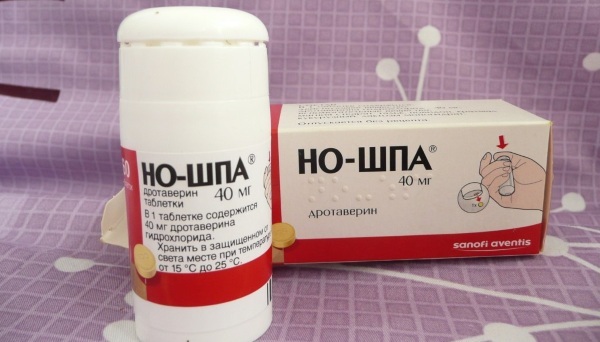 They relax smooth muscles and reduce vascular tone. "No-Shpa" - 2 tablets 2-3 times a day, but often enough to stop the attack once. "Spazmolgon" drink 1 tab. during an attack. During attacks, it shrinks proudly and the tablets are difficult to swallow. Therefore, intramuscular injections are given instead. They relax smooth muscles and reduce vascular tone. "No-Shpa" - 2 tablets 2-3 times a day, but often enough to stop the attack once. "Spazmolgon" drink 1 tab. during an attack. During attacks, it shrinks proudly and the tablets are difficult to swallow. Therefore, intramuscular injections are given instead. |
| Antihistamines | These drugs are prescribed if the cramping has been caused by an allergic reaction. "Suprastin", "Tavegil" drink 1-2 tablets a day or do intramuscular injections. |
| Bronchodilators | Relaxes smooth muscles, eliminate spasms, expand the lumen of the bronchi. "Fenoteir", "Salbutamol" are produced in aerosol. The drug is injected at intervals of 3 hours, up to 4 times a day. "Teofedrin-N" is produced in tablets. The drug relieves spasms and calms the nervous system. Take ½ tablet once, after meals. |
| Hormonal | Hormonal drugs are used once - only to relieve an attack. For example, "Dexamethasone" is injected intramuscularly for swelling of the throat, shortness of breath. The drug acts quickly, but hormonal agents are used with caution. They have strong side effects and can be harmful if used frequently. |
| NSAIDs | These drugs are prescribed if inflammation is the cause of lingospasm. For example, “Nise” is drunk 1-2 tablets a day. Stop taking as soon as the medicine stops symptoms. NSAIDs simultaneously act as a pain reliever.
|
| Antibiotics | Antibiotics are prescribed if infectious diseases are the cause of laryngospasm. Several groups of these drugs are produced. The choice of medication depends on the infectious agent, but more often a broad spectrum of action is prescribed. The course of treatment is 5-7 days, maximum 14 days. |
| Sedatives | Prescribed if the attacks are caused by stress, emotional overexcitation. The safest "Motherwort", "valerian infusion". 40 drops are poured into a small amount of water and drunk 2-3 times a day. But these funds need to be taken for a long time, so sedatives are more often prescribed for the chronic form of the disease. |
| Homeopathic | They help prevent convulsive constriction of the glottis:
|
The cause of laryngospasm may be vitamin deficiency. Then the treatment is based on vitamin complexes.
Surgical operations
Laryngospasm in adults (symptoms and treatment may indicate the need for surgery) is sometimes relieved by surgery alone. It is indicated at a high risk of developing suffocation.
Can also be performed:
- tepeotomy - dissection of the thyroid cartilage;
- tracheotomy - elimination of spasm, restoration of breathing;
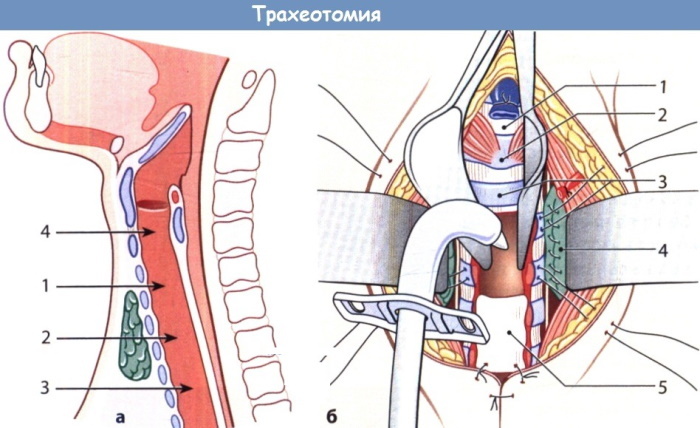
- conicotomy - an operation in the area of the conical fold;
- cricotomy - remove the arc near the cricoid cartilage;
- dissection of the trachea - removal of foreign bodies, providing oxygen access.
With complete overlap of the larynx, tracheal intubation is performed. A tube is inserted into the throat through which oxygen is supplied and the patient can breathe.
Physiotherapy methods
Physiotherapy methods are used as an auxiliary treatment. They help to reduce the frequency of attacks, improve the general condition. If the cause of the spasms is the defeat of the bronchi, then massage and physiotherapy exercises will be effective. Also, electrophoresis, inhalation procedures based on herbal preparations are prescribed.
Acupuncture (acupuncture) is helpful for laryngospasm. The needles are inserted at specific points on the body. This helps even with a chronic and advanced form of the disease. The procedure activates the protective functions. As a result, the body will begin to recover on its own. Acupuncture soothes the nervous system, relieves pain and inflammation, and improves metabolic processes.
Traditional methods
There are several methods that are used to stop a mild attack. You need to hold your breath for 5 seconds, then slowly exhale the air through your compressed lips. Repeat until the attack has passed. During an attack, take a straw in your mouth and draw in air through it. This helps to relax the ligaments, stimulates slow breathing.
Folk remedies:
- To expand the bronchi 2 tbsp. l. 1-2 liters of boiling water are poured over baking soda. After dissolving the crystals, the agent is used for steam inhalation. The duration of each procedure is 5 minutes.
- To reduce spasms, restore the nervous system, tea is prepared with chamomile, lemon balm, valerian and mint. The components are taken in equal proportions. Then 1-2 tbsp. l. the mixture is poured with a glass of boiling water. Insist 20 minutes, filter. If the tea is too concentrated, then it can be diluted with water.
- Add 1 tsp to a glass of milk. l. honey, a pinch of nutmeg, cloves and cinnamon. Then the mixture is heated and drunk warm. Milk with spices and honey will soften the respiratory tract.
- Rub 200 g of rowan berries through a sieve. Add 100 g of granulated sugar to the mixture, stir until it is completely dissolved. Transfer the product into a glass container. Keep tightly closed. Take 1 tsp daily. l., on an empty stomach.
- In equal parts, mix hawthorn, oregano, beetle. To them are added in the same proportions coltsfoot, meadow clover and Veronica officinalis. Take 1 tbsp. l. mixture of herbs, pour 300 ml of boiling water, insist 10 tsp. filter and drink warm in half a glass, 5-6 times a day.
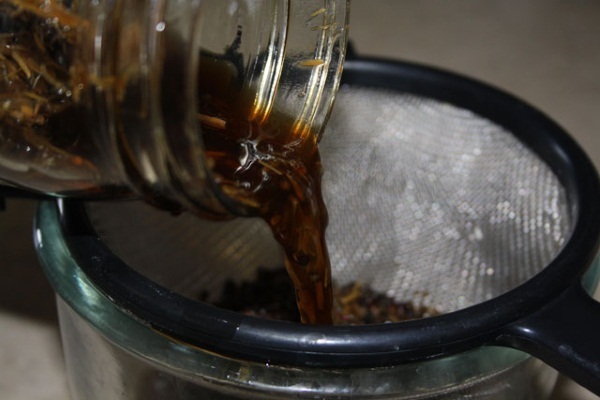
- Mix in 1 tbsp. l. chopped ginger root, rosemary, meadow geranium. Thyme, mariannik, mint are added to them in the same amount. The mixture of herbs is transferred to a glass jar and 1 liter of warm red wine is poured. Add ½ tsp. l. ground red pepper. The drink is insisted for two days, filtered and drunk before bedtime, 50 ml each.
You can take advantage of the impact on a special point. With laryngospasm, it is located just above the jaw, behind the earlobe. You need to press hard on the point - down towards the throat. If performed correctly, then soreness appears, and the spasm passes. Warm baths with potassium bromide solution can also help. Laryngospasm is relieved by touching the root of the tongue with a spoon.
Possible consequences and complications
The main thing during an attack is not to be nervous, not to panic. This will only aggravate the seizure and worsen the condition, sometimes even death. When a severe form of laryngospasm is diagnosed, accompanied by several attacks per day, which are difficult to stop, this poses a serious threat to health.
Severe seizures can cause additional injury. The inability to breathe air causes hypoxia and oxygen starvation of the body, disruption of the brain. Failure to provide medical assistance during an attack will result in disability or death of the patient.
Laryngospasm in adults (symptoms may be similar to other pathologies, therefore, treatment is prescribed only after diagnosis) in most cases is treated quickly. If the disease is mild, then the risk of complications is almost excluded. Laryngospasm is rarely fatal if immediate medical attention is provided.
Laryngospasm videos
What is laryngospasm in adults and children:

